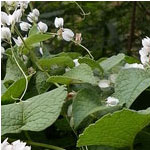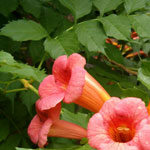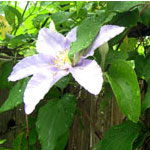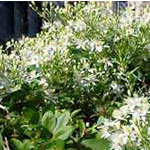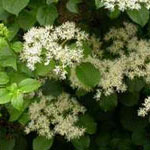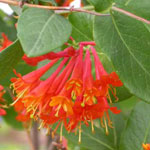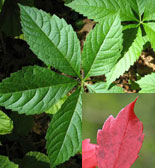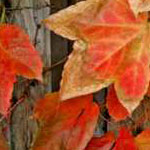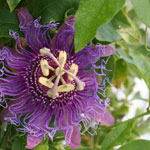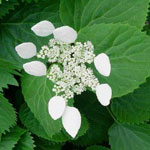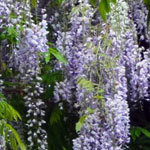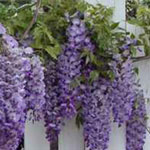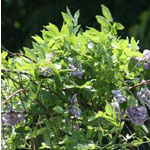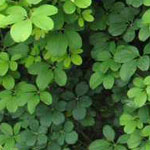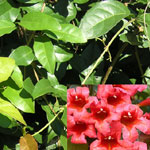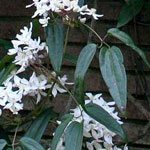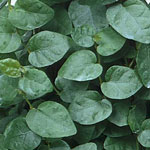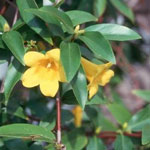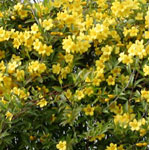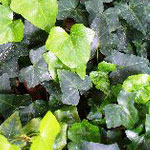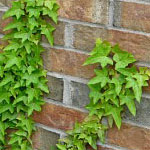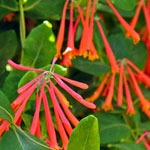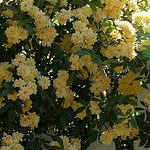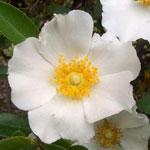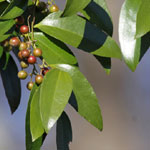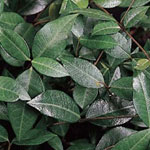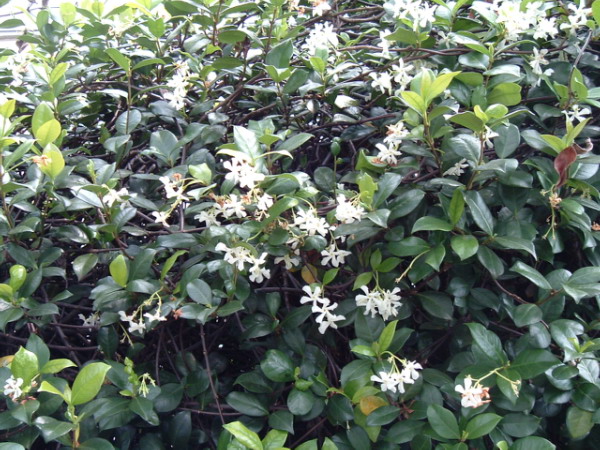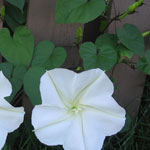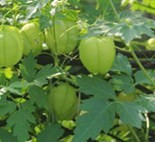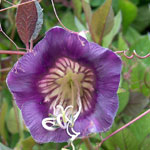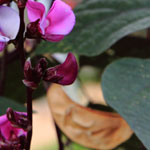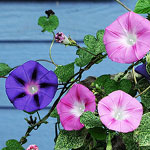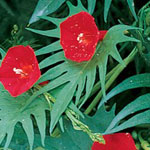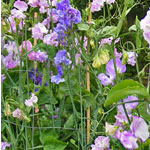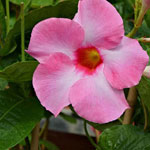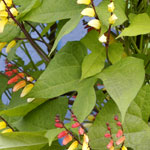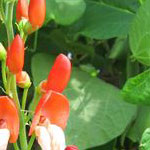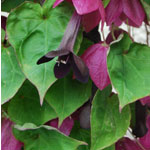Vines have many useful purposes in your landscape. They can screen unsightly views or provide privacy for a patio or porch. For those with limited space, vines can act as dividers or barriers. And a vine placed along a fence or blank wall will break the monotony and help soften harsh structural lines blending the structure with the surrounding landscape. A vine grown on an arbor can give shade much sooner than most trees can and will add height to a garden where needed. Vines can even be used as ground covers on steep banks where a lawn will not establish.
Selecting your vine, of course, depends on its intended use, location, soil adaptability and type of support. You would want to choose a dense, coarse foliage if a screen is needed, where a fine-textured, slow-growing vine would work well to add pattern and interest to a stone or brick wall. Many people like to plant fragrant flowers near windows or near porches and patios so when looking out you view the beautiful flowers or while walking by smell the fragrance. You would need a vigorous, tall growing vine such as grapes or wisteria for a large arbor, but would want to choose a much smaller vine to decorate a mailbox. So it is important to think of the vine's intended use as you choose your vine.
Vines are broken down into three categories which are defined by their method of climbing: tendrils, twining or clinging. Your selection of vine type and support must be compatible.
Tendrils are slim, flexible leafless stems that wrap themselves around anything they contact. Grapes are a good example of a vine that climbs by tendrils. Tendrilled vines will need supports such as wire or thin wood stakes. Twining vines wind their stems around any available support. Honeysuckle and wisteria use this method of climbing. Twining and tendril-type vines climb best on wires, trellises and arbors. Clinging vines, like Boston ivy, climb by attaching small root-like hold fasts to walls, trees or other rough-textured surfaces. Clinging vines can be used on either brick or masonry walls but should never be used on the walls of frame buildings. They can damage the wood.
DECIDUOUS VINES
| COMMON NAME BOTANICAL NAME | PHOTO | HEIGHT | ORNAMENTAL FEATURES | GROWING CONDITIONS |
| Coral Vine
(Antigonon leptopus) |
|
30 feet | Very vigorous late summer blooming vine with vivid pink flowers. | Full sun, well-drained soil. Hardy only near coast. Tendrils. |
| Trumpet Creeper
(Campsis radicans) |
|
30 feet | Bright orange trumpet-shaped flowers in summer attract hummingbirds. | Full sun. Tolerates heat and drought. Clinging. |
| Large Flowered Clematis
(Clematis hybrida) |
|
5 to 20 feet | Many colors and patterns in large flowers are available. | Sun, but keep roots cool and shaded. |
| Autumn Clematis
(Clematis terniflora) |
|
30 feet | Masses of small fragrant white blooms in late summer and fall. | Sun, but keep roots cool and shaded. |
| Climbing Hydrangea
(Hydrangea anomalasubspecies petiolaris) |
|
60 to 80 feet | Glossy foliage and large white flower clusters in summer. | Partial shade to full sun. Moist, well-drained soil. Clings. |
| Goldflame Honeysuckle
(Lonicera x heckrotti) |
|
12 feet | Red flower buds open to yellow flowers in spring through summer. | Full to part sun. Drought tolerant. Attracts hummingbirds. Twining. |
| Virginia Creeper
(Parthenocissus quinquefolia) |
|
10 to 20 | Rapid-growing native vine with coarse foliage. Excellent fall color. | Sun to part shade, climbs by tendrils. |
| Boston Ivy
(Parthenocissus tricuspidata) |
|
50 to 60 feet | Glossy leaves turn orange-red in fall. | Partial shade to full sun. Moist soil. Does poorly in hot, dry areas. Clinging. |
| Passionflower or Maypop
(Passiflora incarnata) |
|
10 to 15 feet | Beautiful, intricate purple and white flowers on a lovely native vine. The fruit is sweet and aromatic. | Full to part sun. Dies back to ground in winter. Tendrils. |
| Japanese Hydrangea Vine
(Schizophragma hydrangeoides) |
|
30 feet | Showy white flower clusters. Dark leaves are marbled with silver in variety ‘Moonlight.’ | Sun to shade, moist soil.
Clings to trees and walls. |
| Japanese Wisteria
(Wisteria floribunda) |
|
30 to 50 feet | Fragrant, hanging clusters of lavender, white or pink flowers in spring. Blooms as leaves emerge. | Full sun to part shade. Moist, well-drained soil. Do not over-fertilize. Twining, needs strong support. |
| Chinese Wisteria
(Wisteria sinensis) |
|
30 to 50 feet | Blue-violet flowers, but not as fragrant as Japanese Wisteria. Blooms before leaves appear. | Same as above. |
| American Wisteria
(Wisteria frutescens) |
|
25 to 30 feet | Fragrant lilac purple flower clusters in spring. Less invasive than Chinese and Japanese wisteria. | Same as above. Blooms on current season’s growth. ‘Amethyst Falls’ is an excellent cultivar. |
EVERGREEN VINES
| COMMON NAME BOTANICAL NAME | PHOTO | HEIGHT | ORNAMENTAL FEATURES | GROWING CONDITIONS |
| Fiveleaf Akebia
(Akebia quinata) |
|
Up to 30 feet | Rapid-growing vine with small purple flowers. Light, fruity scent Attractive foliage. | Almost any site in sun or shade, wet or dry conditions. Twining. |
| Cross Vine
(Bignonia capreolata) |
|
Up to 50 feet | Showy orange or reddish orange flowers in late spring. Flowers best in full sun. | Tolerates any soil. Sun or shade. Clinging. |
| Armand's Clematis
(Clematis armandii) |
|
15 to 20 feet | Long glossy leaves. Fragrant white flowers in early spring. There are pink cultivars. | Provide winter shade to prevent sun scorch. |
| Climbing Fig
(Ficus repens) |
|
Up to 50 feet | Fine, heart-shaped foliage clings tightly to walls. | Moist, well-drained soil, partial shade. Damaged below 10 F. |
| Autumn-Flowering Jessamine
(Gelsemium rankinii) |
|
10 to 20 feet | Flowers in autumn as well as in spring, non-fragrant yellow flowers. | |
| Carolina Jessamine
(Gelsemium sempervirens) |
|
10 to 20 feet or ground cover | Bright yellow fragrant flowers in early spring. State flower of South Carolina. | |
| Algerian Ivy
(Hedera canariensis) |
|
Up to 50 feet | Large, luxuriant, thick and leathery foliage. | Partial shade. Moist, well-drained soil. |
| English Ivy
(Hedera helix) |
|
20 to 50 feet | There are many varieties of ivy available with a variety of leaf forms, patterns and colors. | See above. |
| Evergreen Honeysuckle
(Lonicera sempervirens) |
|
8 feet | Spring-flowering native with orange-scarlet flowers. ‘Sulphurea’ is yellow flowered. | Sun to part shade, moist well-drained soil. Twining. |
| Lady Banks Rose
(Rosa banksiae) |
|
10 to 15 feet | Long slender canes with an abundance of violet scented pale yellow flowers in spring. | Full sun. Moist, well-drained, fertile soil. Climbing roses are not self-supporting. |
| Cherokee Rose
(Rosa laevigata) |
|
10 to 12 feet | Long, thorny, vine-like canes bear pure white single flowers in spring | Full sun, to some shade. Moist, well-drained, fertile soil. |
| Evergreen Smilax
(Smilax lanceolata) |
|
Can reach 30 feet | Very beautiful foliage. Excellent screen on trellises. | Part shade. Rich, well drained soil. Tendrils. |
| Japanese Star Jasmine
(Trachelospermum asiaticum) |
|
15 feet or ground cover | Smaller foliage, yellowish white flowers. More cold hardy than Confederate Jasmine. | Part shade, moist, well-drained soil. Twining. |
| Confederate Jasmine
(Trachelospermum jasminoides) |
|
30 feet or ground cover | White flowers, sweetly scented in spring. ‘Madison’ is hardier. | Part shade, moist, well-drained soil. Twining. |
ANNUAL VINES
| COMMON NAME BOTANICAL NAME | PHOTO | HEIGHT | ORNAMENTAL FEATURES | GROWING CONDITIONS |
| Moon Vine
(Ipomoea alba) |
|
15 feet | Large, 4-inch, fragrant white flowers open in the evening and last through the night. | Full sun with well-drained soil. Notch seed coat with a file and soak overnight before planting. |
| Love-in-a-Puff
(Cardiospermum halicacabum) |
|
10 feet | Small white flowers followed by puffy fruits. The seed has a heart-shaped mark. | Full sun and well-drained soil. |
| Cup and Saucer Vine
(Cobaea scandens) |
|
20 feet | Green blossoms mature to deep purple. Fascinating foliage. | Full sun. Moist, well-drained soil. Tendrils at end of leaves. |
| Purple Hyacinth Bean
(Lablab purpureus) |
|
10 feet | Purple blossom spikes followed by bright purple bean pods. | Easy to grow, requires a sunny growing area. |
| Morning Glory
(Ipomoea purpurea) |
|
20 feet | Fast-growing vine with 4-to 5-inch-wide flowers in white, blue or red. | Warm sunny location, tolerates some drought. Soak and nick the seeds before planting. |
| Cardinal Vine
(Ipomoea x multifida) |
|
20 feet | Small brilliant red flowers above ferny foliage. | Warm sunny location, tolerates some drought. Soak and nick the seeds before planting. |
| Sweet Pea
(Lathyrus odoratus) |
|
6 feet | Blue, pink, purple, red or white fragrant flowers in spring. Grow as winter or spring annual. | Cool temperatures, moist, well-drained soil. Remove old blossoms to keep the plant flowering |
| Mandevilla
(Mandevilla splendens) |
|
10 to 15 feet | Pink funnel-shaped flowers, leathery dark green leaves. | Sun or light shade, well-drained soil. Mandavilla is a tropical vine and can be brought in for winter. |
| Spanish Flag
(Mina lobata) |
|
20 feet | The flowers are at first red then fade through yellow to cream. | Full sun, well-drained soil. Soak the seed before planting. |
| Scarlet Runner Bean
(Phaseolus coccineus) |
|
10 feet | Fast-growing vine produces clusters of brilliant red flowers and edible beans. | Full sun. Rich, well-drained soil. |
| Purple Bell Vine
(Rhodochiton atrosanguineum) |
|
10 feet | Purple, bell-shaped flowers. | Full sun. Moist organic soil. |



